Mugello, Part 2
An Inside Look at MotoGP
Behind the Garage Door With Ben Spies and Tom Houseworth at the Gran Premio d' Italia at Mugello, Tuscano Italy
By Samuel Quarelli Fleming & Melissa Berkoff
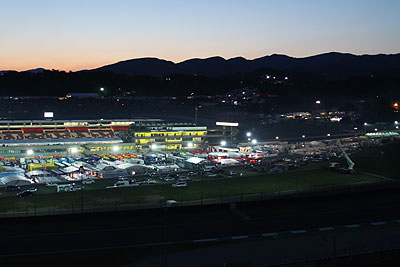
Saturday evening at Mugello. Ducati stand is just above the light in the
center of the picture, a new permanent grand stand (center left) spells
out "Mugello Circuito", rider RV are center right, the track is in the
foreground and the row of hospitality tents are lit up and inviting, as
long as you have the correct credential.
Yamaha Factory Racing invited Roadracing World editors Sam Q Fleming and Melissa Berkoff to be embedded with Ben Spies' MotoGP squad at the 2011 Mugello race. This level of access has never been granted to any journalist in the past. Some access was restricted to allow Spies to focus on his race routine and to preserve technological secrets from Sam and Melissa's trained eyes and ears. The following series of articles convey the exotic, and the familiar, about racing motorcycles at the highest level.

Ben warming the tire from the inside.
It’s Saturday, between morning practice, and afternoon qualifying. Ben is about a second off the fastest riders, and Crew Chief Tom Houseworth is contemplating his options to make the bike faster.
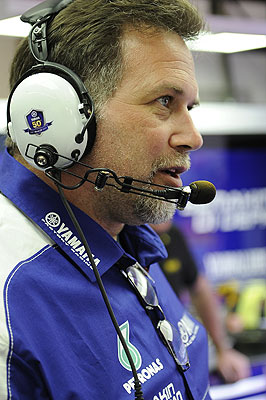
Houseworth's eyes brighten as Spies jumps to
second on the qualifying leaderboard.
“We never heard Ben mention that he didn’t have enough grip. That means we can take grip away and use that grip to improve the steering and also lengthen the bike. Making the bike longer will automatically make it faster because the longer it is the less wheelie control will kick in. We are going to lengthen the bike 4mm at the swing arm and also increase the length at the front end. This track is all sweepers so we are going with the sweeper set up.”
Now, when Houseworth says “longer” he is talking about miniscule changes. But miniscule changes matter when you are talking about the sharpness of a razor. It is the difference between baby soft skin, and ingrown stubble. The 4mm- longer rear axle placement reduces torque on the shock a minute amount so usually they would reduce the spring rate by 1kg to compensate. That is a teensy, tiny change. On this morning, they are not going to reduce the spring rate because Houseworth feels that the slightly stiffer spring is in their best interest.
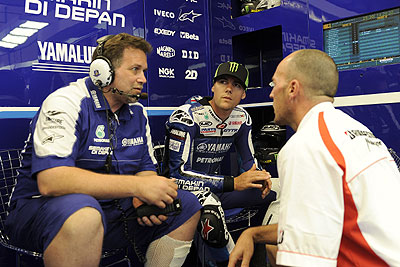
Houseworth, Ben, and Bridgestone tire tech Peter plan tire strategy.
Ben and Tom’s current challenge is to figure out a way to allow the bike to develop more grip in low- speed turns so that the traction control and wheelie control won’t limit the engine as much as they do currently, while also allowing for better 'turnback'. 'Turnback' is “Ben talk” for the motorcycle's ability to turn at the exact moment of apex. This is not, notably, the ability to finish a turn ("Ben is the only rider I have ever worked with that doesn't care about the exits," –Houseworth says) but the precise instant where the wheel speed graph troughs in the turn and the acceleration is just about to begin. They are tuning for what amounts to the Instant of Apex.
All of the suspension and geometry is set up with spreadsheets and math. Nothing is ever actually measured in the garage. This was Houseworth’s practice racing AMA superbikes but it was not a common practice in World Superbike. It was, however, already de rigueur in MotoGP.
“We collect a lot of data. I mean, we collect data on everything. But at the end it is experience that guides our decisions. We have looked at the suspension data to figure out where we are in the stroke at different points on the track, but ultimately that data just informs our decision. The decision to go with a longer, sweeper- oriented set up is based on experience."
Houseworth also notes that they use to the data as a memory trigger for Ben. Spies can’t remember everything, so they use the data to ask him about specific anomalies to learn, for example, why he’s not accelerating hard out of a certain corner (“There’s a bump there”) or why he’s shutting off for multiple corners (“The bike won’t turn.”).
Houseworth takes a moment to compare notes with Japanese engineer Hiroya Atsumi. Atsumi has been looking at all the operating guidelines of all the test data that Yamaha has acquired to make sure that Ben and Houseworth don’t stray off the reservation into uncharted waters. After examining throttle position data, Houseworth points out, “Ben is closing the throttle in the transitions in six spots on the track. He should only be closing the throttle in two spots to make transitions. He is not rushing the corners (i.e., carrying too much entrance speed to properly make the apex), so we need to make the bike steer faster so he can make the turns without shutting off.” This is a problem because lengthening a bike usually makes it steer slower so now they are bumping up against one parameter by addressing another.
Houseworth sits quietly thinking of all the handling changes he has made on all the motorcycles he has tuned in the past.
“Woody!” he shouts across the garage to mechanic Gregory “Woody” Wood. “Raise the back!”
While the crew set to making the geometry adjustments, Houseworth elucidates on his experiences in GP, and his tuning methods in particular.
“In World Superbike we only had one year so we didn’t have any past data. We had to start from scratch, and we had to improve the bike, the setup and the operation of the team very quickly. In GP we now have last year’s data from Tech 3 so we can refer to that set up data when we go to each track. But the factory bike is far enough off, and Ben is faster, that the settings from last year are not quite applicable. Each weekend we learn and improve so we start with the last weekend’s race set up and work from there.”
“We started the bike with Assen's (the last race, where they also achieved their first win) set up and now we are going longer and leaving it tall. Longer is less wheelie prone which gives more speed because we get less wheelie control (since the power is limited on the bike when it lifts the front wheel) but the longer we go, well, it’s going to cost us some side grip. Between Arrabbiata 1 and Arrabbiata 2 (two high speed turns at Mugello that literally translate into Angry 1 and Angry 2) the tires continues to heat up and can get greasy by the end of the three rights there.”
“There are five parts to any corner: entry, tip in, mid- corner, transition and drive. Bridgestone changes the tire from weekend to weekend so we need to know where the compound transition is for whatever tires we are using that weekend because we might want to adjust the spring, the geometry, or Ben’s riding style to optimize the transition between the mid corner and the drive.”
An engineer approaches, and they quickly confer on the idea of changing the fork spring rate...by .01kg. A miniscule change. Most riders would never notice it. Houseworth chooses to use the spring that is infinitesimally stiffer but with less preload to optimize Ben’s moment of ‘turn back’.
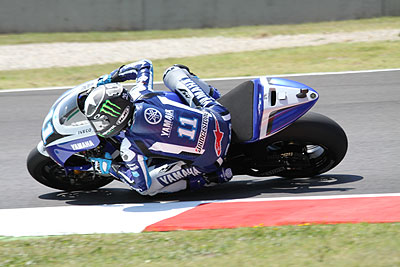
Ben Spies at the moment of 'turn back'.
Ben sticks his head around the corner to compare notes with Houseworth. Houseworth gives him the geometry changes they are going to run in reference to their base line. Ben asks, "What are they running?"
Houseworth "Jorge is at +X and +Y" (variable names used instead of numbers in accordance with YFR's wishes).
Ben: "Hmmm...k" and exits.
Houseworth continues: "You would think it would help to know the set up of the other riders but it doesn't really matter. What works for Jorge Lorenzo probably won't work for Ben. They are different lengths, different weights, and have different riding styles. It is useful to know for reference but we really follow independent paths."
“We've got a divided garage from Lorenzo's crew but it's not due to bad blood or anyone being mad at anyone. It just helps us stay focused. If Jorge crashed and they brought in a bent bike, I’d be over there looking at it just like everyone else. That is not going to help us get our work done, and we have plenty of work to do. I can talk to my counter part anytime and sometimes I do, but it is just nice to not have the distraction.”
“We are on engines 3 and 4 right now. We are in good shape for engines. (Rossi is on engine number 5, and twice his bike died in practice.) You don't see folks doing long wheelies or celebrating with burnouts anymore. That is all about engine preservation. Also, the bikes have a timed tip- over switch so our bike will run for a few seconds on its side before dying. Ben knows to get up right away and run over to the bike and turn it off immediately to keep the motor from oil starving on its side."
At 1:55pm on Saturday afternoon the track goes green for MotoGP qualifying. Tuscany has been a world-renowned center for cuisine and agriculture for 3,000 years. Its golden sunlight is only rivaled by its lush verdant hillside. Of course, chlorophyll that rich is only possible with constant hydration, and a slight rain starts to fall. The track is still dry but the question on everyone's mind is, "Do we push hard now to get a fast lap before the track is soaked, or hope the rain stops and the track dries completely so that hyper- fast entry speeds and 54- degree lean angles are not hazardous as hell on a slightly damp track?"
Ben takes to the track and completes a few laps trailing Simoncelli. If one turn is wetter than expected, Ben may be able to see his rival slide in time to adjust his entrance speed. With everyone feeling out the track conditions the speeds are slow and they are five seconds off the lap record pace.
Ben comes back after a few laps. He picks up a clear helmet shield, they swap front and rear tires (including the mandatory front rotor swap) and the tire temperatures are checked. Houseworth and Ben compare notes while the TV crew puts a camera in Ben's face.
Houseworth directs Woody: ".4mm more ride height, I want a little more weight on the front."
Ben retakes the track and is immediately faster but no one can know if it is because the track is drier, his confidence is higher or the set up changes improved the bike.
At 2:13 he is running fifth in the order. Stoner lays down a 1:48:05. That is a fast lap. Although in the dry morning warm- up the pace was a bit faster, :48s are fast laps.
At 2:17 Spies puts down a 1:48.479, taking him to second on the time sheet. There is no celebration in the garage, no shouts of glee or jubilation, but those watching carefully would see the faintest smile on Houseworth's lips and a brightening of his eyes.
Ben comes back in. "It's a little better, it felt faster."
At 2:24 qualifying continues and Ben's bike remains on its stands. Ben watches the monitors with his helmet on and sips water. Technicians are arrayed around him in case he makes an observation that requires action.
At 2:25 Ben rolls back out of the garage while conditions worsen on the track. Mary Spies leans into Houseworth and expresses her concern about the slippery track.
Houseworth consoles her with, "If there is one thing Ben isn't, it’s 'dumb'."
Mary rejoins: "Do you want to take credit for raising him right or can I?" and the two share a laugh.
Ben rolls back in and takes off his helmet. "It’s getting worse out there, no one is going to go faster."
Although there is time left in qualifying, that proclamation guarantees that Ben will be starting from the front row in second spot and they begin their debrief before the required appearance at parc fermé for the top three qualifiers.

Ben qualifies on front row, Woody is pleased as well.
Ben offers: "The bike is better than this morning. The longer wheelbase is definitely better but it is still wheelieing a lot. It is a little slow in transitions. It is really stable but the steering is slow. I want the same weight distribution but more feel on the front and faster transitions. In turns 1, 6, 9, and 12 I'd like to get a little more pitch to the rear on the throttle." And with that he has to exit the garage for a media interview in parc fermé.
Houseworth contemplates Ben's observations while Woody and the other mechanics begin to strip the bike. Every part on the M1 has a serial number. Each serial number's usage is tracked by Takehiro Suzuki, the part's manager. He has determined that, based on mileage, it is time to replace the exhaust pipe and headers, the radiators, the shift lever and the shift lever sensor. These are some of the most beautiful and exotic race parts in the world.

Melissa Berkoff abandons her journalist objectivity to celebrate Ben’s
front row starting position while Mary "Mama" Spies abandons her media
composure to offer a commentary to Ben's doubters.
To keep us from getting drool on his new titanium oval ported header pipes, Houseworth calls us over. "I am thinking about going .4mm on the ride height but I don't know which way yet. Also, I think we are going to change the trail 2mm but again, I am still thinking through which way I want to go."
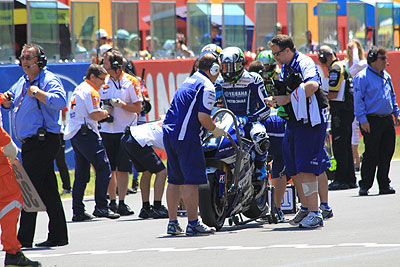 |
|
“It becomes routine but I still can appreciate that I am working on the
best motorcycles in the world. The pieces are beautiful, the billet cases,
the aluminum gas tanks, the radiators. It sometimes hits me where we are
and what we are doing. People make fun of me for it but I started taking
pictures of the other bikes on the grid just to help remember
that we are here." –Tom Houseworth
While we chat with Tom, mechanic Ian Gilpin gently sponges off and then dries the front brake caliper mounts and the sealing surface on the lower part of the fork legs. Earlier, while walking into the garage we had noticed another team washing forks and calipers in a sink outside the garage. I ask Tom, “Is it common to disassemble the bike to wash it?”
“Some of these guys are just a little weird about washing things. They want to take off the swing arm just to wash it. We don’t do that on our bike. Some of the mechanics over here are really the best in the world, others are not very experienced. In the U.S. the mechanics have spent time in WERA and AMA and really are pretty good. In Europe it is tough to get a lot of experience as a race mechanic. It just costs a lot of money for these teams to fly Americans over from the USA for the rounds. It is a lot of business class tickets over a year."
"We usually come for a week. We fly in on a Tuesday and fly home on the Monday after the race weekend. We do all work on the bikes at the track. We build them at the beginning of the season at the first test. There is no manual or diagrams or anything but it is obvious to us how they go together so it isn’t a problem to build them. You get an engineer and you get a box of parts. They expect you to already know how to play the piano when you get there. We built both bikes for the first time with three guys working for 12 hours."
Woody chimes in with: “I got a frame and a five gallon bucket of bolts, and an engineer who said 'Put together.'”
Houseworth continues: "The really impressive thing is how much support there is here. I was talking with Atsumi about some suspension ideas after Catalunya. He walked up to me at the next race with a list of my suggestions and said, 'These worked like this, these ones didn't.' I sort of stared at him for a minute and then said 'Are you telling me that you went and tested all these ideas?' He nodded. So it turns out that he wrote down all my ideas and they went to the track and tested them all. I have a test rider somewhere that I didn't even know I had!"
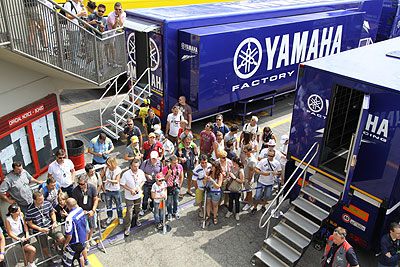
A crowd of fans with green paddock passes gather at the barrier to catch a
glimpse of Ben as he walks from the garage into the trailer to change out
of his leathers. Often this means the riders need to take a few
minutes for pictures and autographs as well.
Race day dawns Sunday with clear skies and a perfect forecast. At 9:00am the track announcer welcomes the 83,000 fans with a rousing "benvenuti al Gran Premio d' Italia!". Rain had tempered attendance for the Saturday qualifying and the vibrant hillside parties but Sunday the fans descended en masse. The dual security fences around the track had been re-enforced with razor wire to discourage the traditional post- race track invasion. However, this being Italy (an eminently practical nation), this morning the track officials had circulated a bulletin to all the teams informing them to promptly secure their machinery and close their garages at the end of the race because the security teams would be opening up the gates to allow fans to flood the track.
After the morning warm up Ben is fourth fastest with Stoner, Simoncelli and Dovizioso ahead of him and Lorenzo just behind him.
Ben debriefs with, "The bike is good everywhere and the improvements are working. The electronics are smoother too. The bike wants to back in to turn one but we've never gone this fast with the hard rear so I think it’s okay."
Houseworth: "Ben might switch the engine control map to a more rider- involved map as the tire drops off towards the end of the race.” In other words, once the traction controls starts to limit the bike’s power too much, Ben turns down the engine control of the tire so he can try to drive harder than the ECU would otherwise let him.
After the build up from the weekend, and with massive crowds roaring every time Rossi or a Ducati makes an appearance on the TV screens, the race is, as so often the case, a little anticlimactic.
Ben was third into turn one but got pushed wide and lost touch with Stoner, Lorenzo and Dovizioso. Stoner led most of the race but was passed in the closing stages after he lost rear grip by Lorenzo and then by Dovizioso. Ben felt that he made a couple of mistakes in turns 3 and 6 that dropped him back a couple seconds early on. Once he lost touch with the lead group, he ended up with Simoncelli and, rather than swap paint for no ultimate gain, he followed the potato chip- sponsored rider until the closing laps before repassing for a fourth place finish. A number of times during the course of the race Ben was running the same lap times as the front running bikes so the 8.9- second margin from race winner Lorenzo was due more to time he gave up by following Simoncelli rather than a systemic problem with the bike.

Spies passes Simoncelli in the closing stages of the race to take fourth place.
Playing to the crowd, the TV feed mainly followed Rossi as he made his way from tenth to sixth.
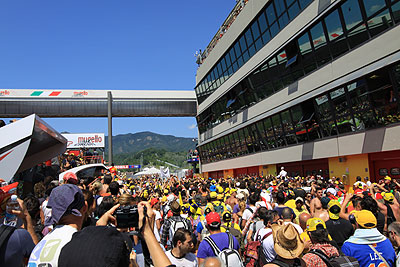
The guards opened the gates and allowed any of the 83,000 attending fans
who wished to walk down to parc fermé and hot pit lane to do so. The result
was a jubilant and incredibly well behaved invasion of pit road, with fans
saluting the riders poised above them like royalty on the podium balcony.
One team member offered that the front tire on Ben's bike was not working well in the first laps of the race. The front Bridgestones are notoriously difficult to heat to their proper operating temperatures (see Rossi on Ducati).
The Yamaha team, as a whole, was ecstatic with Lorenzo's win but Ben's side of the garage was both subdued and circumspect. It seemed that everyone there, including us, had thought a podium finish was possible.
Houseworth deconstructed the race,: "Obviously we are really close, but we need to address a problem that the test rider's are not feeling. We need to make a bigger change to the front and have Ben test it at the next race at Sachsenring. He's been giving us the same comment since Estoril, and so we just need to make a little bit bigger change and see what it does."
The crew then turned to breaking down the pit set up and loading it all into the transporters.
"It was fun having you guys here,” Houseworth said. “You've seen and heard things that no journalist has before."
By 10:00 p.m. Sunday evening, the Yamaha race trucks had rolled out of the pits.
